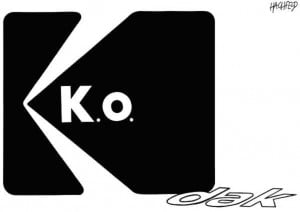The offer is only one building block to fulfill the value proposition
One of the beauties of the business model thinking is that we learn to see a business totally different if we really apply stringent thinking and dissect a business into its building blocks. And one of the most important concepts is that the value proposition is not the product.
Why?
It’s not the product that creates value but the value proposition. The whole value architecture including the product, the revenue model and the team & values all have to deliver the value the value proposition is proposing.
Deadly business with a value proposition that customers and democracies need
A simple, a bit eccentric example illustrates this. Take manstopper ammunition that is for very good reasons banned by the Hague Convention in international warfare.
Manstopper ammunition does not sound like a lovable product and in terms of Alex canvas as a good value proposition?
Actually, manstopper ammunition is the offer and not the value proposition. A good, and even meaningful value proposition depends from your customers, the job-to-be-done and the benefit you create for your customers.
These building blocks make up the value proposition. The offer aka product is just one part to fulfill the value proposition. That is extremely important distinction.
What is a meaningful value proposition for manstopper ammunition?
If you see the police in western democracies as your customers and you deliver with the ammunition a safe method for them to stop dangerous criminals like terrorists or plane hijackers than you have a good value proposition.
You do not have to like this kind of business but in a democracy the state has the monopoly on legitimate use of force even of lethal force. And in such context, manstopper ammunition has for S.W.A.T. and the hostages a huge benefit since it reduces the risk of collateral damage and of death of the hostages.
You might not like this drastic example but it illustrates the difference between the offer and the value proposition. The value proposition is delivered later by all building blocks of the value architectures. In the ammunition case, a distribution system that only allows police corps to purchase this ammunition is key to delivery the value proposition.
The value proposition is where the value is defined. The whole business model has to deliver the value proposition, even the revenue model since the right pricing adds value as well. And a good value proposition gives meaning to the employees as well. At the same time, the team & values have to support and fulfill the value proposition as well.
Mechanical watches: From a timepiece to a piece of jewelry
Another example to show why it is important to distinguish product and value proposition is the mechanical watch.
Up to the 1970, the value proposition of a mechanical watch was to show the time. With electrical watches, that are much more accurate, this value proposition was not convincing any more and the Swiss watch industry was in decline until it found a new value proposition for mechanical watches. The value proposition of the highly successful Swiss watch industry is that mechanical watch is the only allowed piece of jewelry for man. The mechanical watch was a timepiece and is today a status-symbol. The offer is the same, the value proposition is totally different and all the other building blocks of the business model.
Google’s changing value proposition: From search to finding
The current value proposition of Google is to find information. The product of today to do so is a search engine. In the future we will have context sensible services that give us the right information we might be looking for in the moment. Think about Google Now. The future of searching is finding or the right information at the right time. Google understands this shift in the value proposition.
The missing shift in the value proposition of Kodak: From keeping memories to sharing memories
They did everything right. Kodak invented the digital camera. They have all the patents, but they missed the shifting value proposition customers wanted. Kodak believed that in the digital age, people would still make pictures to keep their memories and therefore they invested heavily in digital printing of digital photos. However, the job a picture does for a customer has changed from keeping memories to sharing memories via social media. Kodak never got that point. They got the technology but never understood the needed shift in their value proposition. Now the business is with Instagram, Facebook or Twitter.
The Kodak is a sad example that you might get the product right (digital camera & pictures) but did not get the value proposition right. Again, a good example to show why it is important to separate the product from the value proposition.
Take-aways
- Always separate the value proposition from your offer. The value proposition is what excites your customers. The products is one building block to create the excitement but has to be supported by all other building blocks.
- Use the building blocks of the value proposition, customers, jobs-to-be-done and benefit, to understand your business better: Play with options to see the shifts how customers see your value proposition.
- Beware of the value perception gap between what you propose and what customers perceive to be your value. It’s a bit like branding. It is not important what you think about your value proposition, it is important what your customers think.



Another really good thought piece from Patrick- timely and relevant and a good reference back to his fluidmind business model canvas that clearly makes you focus on the value proposition